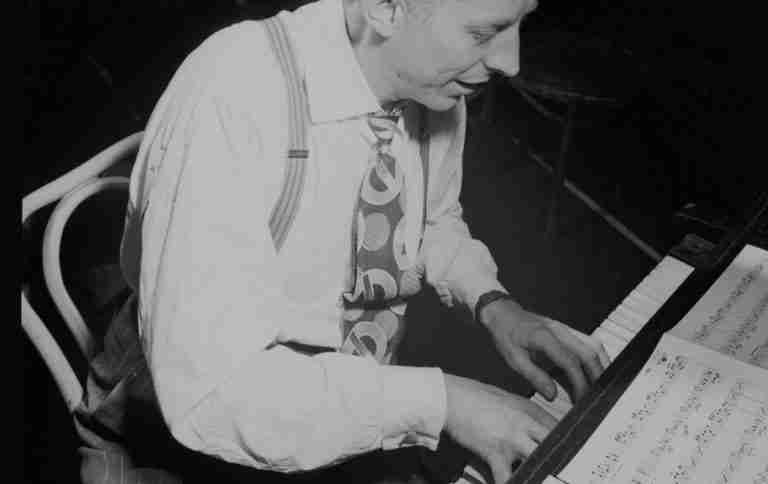Many times we forget about the musical skills that we should be developing until it’s way too late. Right in the middle of a gig you’re put on the spot and in a moment of panic, you realize “$@!*, I should’ve been getting this together in the practice room!”
The bottom line is that when you’re put on the spot, you need to have something to play. In order to not only survive, but flourish in these situations, you must start incorporating certain skills and techniques into your daily practice routine.
Here are 5 essential skills you’ll need as a performing improviser and some solutions on how to start developing them in the practice room:
1) Figuring out the melody and chord changes to unfamiliar tunes
This is probably the most important skill an improviser can have – using your ears to navigate unfamiliar musical situations. If it hasn’t happened already, it’s inevitable that you’ll find yourself on a gig where a tune is called that you don’t know. In these situations, you need to be able to quickly figure out the melody, key, and chord progression to the tune in order to get by.
Solution: The obvious culprit here is your ear. If you have trouble hearing intervals and identifying chords at home, when you get onto the bandstand you’re going to be in trouble. Focus on some fundamental ear training exercises and once you become comfortable with these, work on hearing chord changes. As you begin to improve your ear, try testing yourself by putting on a record with tunes that you’ve never heard before. Challenge yourself to get the melody and changes as quickly as possible – try to get to the point of figuring out the tune after one focused listening.
2) Playing without accompaniment
There are two ways that you might find yourself performing alone on a gig and they’re usually not planned out ahead of time. First, the rhythm section may suddenly drop out when you’re soloing to create a stop time effect or in the same manner, everyone may lay out, and you might find yourself playing only with the drummer. The other situation that you’ll find yourself unaccompanied is at the end of a tune, playing a cadenza and bringing the tune to a logical conclusion. In either case, all of the musical responsibility and attention is on you.
In these situations, you need to have practiced certain skills in order to be able to musically survive. Remember that unaccompanied playing or cadenzas are not simply sections of a tune for the soloist to play whatever they want with out any structure.
Solution: Instead of always practicing tunes with a record, play-alongs, or a few friends, try playing over the form of a tune completely unaccompanied for once. No background tracks, no drummer, just you and the metronome on two and four. This is a very revealing process. You’ll find out very quickly if you “know” the tune, can keep steady time, and have enough language to navigate the harmonic structure by yourself. By developing this skill, when the rhythm section decides to drop out, you’ll be confident with your ability to hold the form together.
To work on cadenzas on the other hand, start by listening to what some of your favorite players do as they play unaccompanied. After studying or transcribing some of these lines, you’ll realize that soloists are using a theme, intervallic motif, or a chord progression as a guide for their improvisation. Listen to this clip of Mark Turner, for an excellent example of this concept:
Transfer this idea to creating your own cadenzas. Try improvising using an interval or pattern and developing that idea, rhythmically as well as harmonically. Or, take a familiar progression like iii-VI-ii-V7, and improvise freely over it using the chord changes as your foundation. Just the act of practicing solos unaccompanied will give you a solid base to work with when you perform.
3) Transposing tunes to different keys
Oftentimes on a gig, especially if you are performing with a vocalist, you’ll be asked to play some tunes in different keys. Not only do you need to be able to transpose music written on the page, but also tunes that you have memorized. Either way, the ability to visualize and play tunes in other keys is a skill that you’ll need to have.
Solution: The first step is to develop the skill to transpose written music. Even if you don’t play a transposing instrument, this is an essential skill. Check out this article on transposing for more on the basics of transposition.
Next, you need to be able to easily transpose any standard that you know to another key. The solution lies in thinking of the chord progression in terms of numbers (I, ii-, V7) instead of letter names (C, D-, G7). For example on the tune I’ll Remember April, rather than visualizing the chord progression as GMaj7 –> G-7 –> A-7 –> D7, etc. think of the progressions as I –> i-7 –> ii-7 –> V7.
As you go to transpose this progression, say to Eb, it will be significantly easier to think of the numeric progression I, i, ii, V7 in the key of Eb rather than thinking “Ok, I’m a minor 6th above G, then what is a minor 6th above A-7?…” It becomes immediately apparent how the process of thinking of progressions in terms of numbers will save you valuable time and mental stress in the heat of the moment. Some basic visualization exercises will also go a long way in helping you to think of progressions numerically.
4) Playing in odd meters (3, 5, and 7)
Oftentimes on gigs, tunes in odd meters (usually 3/4) will be called, and it’s a given that you need to be fluent in this time signature. However, even more challenging is the task of taking a tune that you already know in 4/4 and playing it in an odd meter like 3, 5, or 7. For example, imagine that someone calls All the Things You Are, but in 7. Not only do you have to be comfortable in this new time signature, but you need to get accustomed to dividing up the chord progression in a new meter. This is a task that will be very tricky unless you’ve focused on it and definitely isn’t something that you can do on the fly.
Solution: The solution here lies in becoming familiar with these time signatures and, like any other harmonic progression that’s giving you trouble, you have to internalize the sound. Just as you would listen to a ii-V7 progression over and over to get the unique sound in your ear, you need to listen to tunes in 3/4, 5/4, and 7/4 repeatedly to ingrain them into your musical consciousness and physical understanding of time.
Once you can “feel” odd meters, the next step is to study how to divide the measure in 5/4 and 7/4 into groups of two and three quarters. For example, in 5/4 – [12 123] or [123 12] and for 7/4 – [12 12 123], [123 12 12], [12 123 12]. There are a number of ways to divide the measures and feel the time. So, for instance, if you were playing All the Things in 7, as in the above video, you wouldn’t play seven beats for each chord, you would normally play a bar of four alternating with a bar of three. In order to improvise fluently over this type of form, as demonstrated by Brad Mehldau and his trio, takes some serious work.
5) Be comfortable with all types of acoustic environments and audiences
You can’t always play in your ideal environment and when it comes to performing you’ll encounter all types of acoustic situations and audience types. From performing as soft as you can to gigs where you are barely able to hear yourself, there is no guarantee as to what your performance environment will be like or who will be listening to you.
Solution??
Well, you probably don’t have to go to the extreme of this guy, but you do need to get comfortable in as many playing situations as possible. Practice soft playing, work on projecting your sound to fill a room, play outside where there isn’t any reverb, play in extremely live rooms, etc. Take this same approach to performing in front of an audience as well. Get comfortable playing in front of the most discerning listeners (usually your peers) as well as audiences that could care less. Become confident that you can perform your best in any situation.
One step at a time
You may not be able to conquer these skills quickly in the practice room, but by slowly making headway you’ll be better off than finding yourself unprepared in a moment of panic. All of these skills take years of study and experience to master. Begin by familiarizing yourself with each of these concepts and through continued practice and on the gig experience, you’ll be able to stay afloat in any situation.










